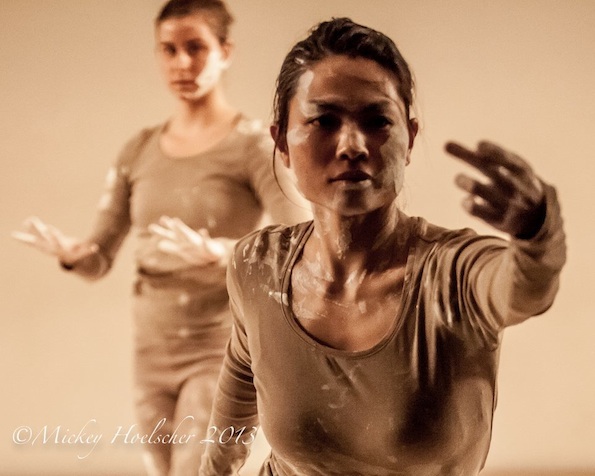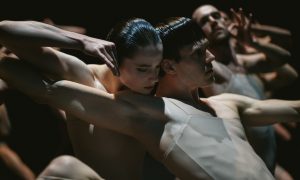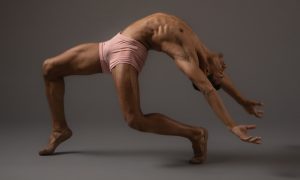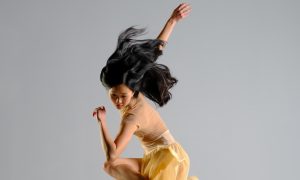By Tara Sheena.
TrioDance Collective is really the product of a dynamic duo: Emily Jeffries and Barbie Diewald. Formed in 2010, the small company has presented its original work in many New York City venues, including The Kitchen and the Center for Performance Research.
Though Jeffries and Diewald both assume roles as artistic directors, the works they present are usually individual showings. In other words, Trio Dance Collective is an example of an important model more and more dance companies are employing these days: resource sharing.
By operating under the same moniker, Jeffries and Diewald have been able to present complete seasons of their work consistently over the past couple of years, as well as an annual emerging choreographer’s festival at the revered 92nd Street Y, Green Line. By pooling resources— whether that be space, marketing for shows or performers— the company has been a consistent force in the vast scene of emerging contemporary choreographers in NYC.
The pair exchanged ideas about their influences, challenges and the importance of time in making new works with Dance Informa.
What originally drew you to choreography?
Emily Jeffries
I have always been attracted to choreography. I am fascinated by physical communication in body language. When I was younger I’d watch and study the way people moved their hands, bodies and lips while holding conversation. Years later, I find choreography to be my clearest form of communication. I am greatly influenced by Carmella Ollero and Sachiko Takimura, dancers I have had the privilege of continually working with for some time. Structured improvisations influence my work a great deal, alongside research.
Barbie Diewald
I remember watching [George Balanchine’s] Ballo della Regina over and over [at age 9 or 10], and having an understanding that someone had made that ballet. I think that was the first abstract ballet I had ever seen, and it was so specific and so virtuosic. One of my ballet teachers, Ken von Heidecke, had a very choreographic approach to class, and we worked with a lot of imagery. He helped me to see the creative core inside the classical discipline, and that has carried through in my work ever since.
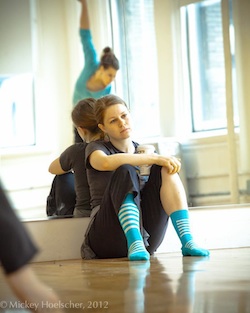
Barbie Diewald in rehearsal. Photo by Mickey Hoelscher.
How would you describe your aesthetic and style to someone who has never seen your work?
Emily
My movement embodies the entire body and mind weaving through gestures and stillness to full bodied dancing that takes up a great deal of space.
Barbie
I like to set everyday gestures alongside codified classical shapes or movements because I like the way they inform each other. I feel like there is a really truthful balance between, say, a beautiful passé and a gesture one might use to swat a fly away. I’m still negotiating that balance, but it definitely comes up in my work.
What is the biggest challenge for emerging choreographers in NYC right now? What are the strategies you’ve employed to navigate that challenge?
Emily
Time is a large challenge for choreographers. New York is very busy, very fast and very full. It takes a certain amount of concentration to slow down and focus on a singular concept or theme, or experiment. To navigate this I schedule rehearsals consistently and structure them to aide in conceptual development.
Barbie
I think the hardest thing to do as a choreographer is to structure my time and my life in a way that fuels my art and nourishes the people who choose to work with me. I’ve found that the best way to do this is to commit to a consistent schedule and to be realistic with what you can expect from your collaborators – in my case, five dancers. After a few years of trial and error, I’ve found a way to make the pieces fit together so that it all works.
What does the title “emerging” mean to you?
Emily
Beginning to be noticed.
Barbie
The word “emerging” implies that I have somehow found my choreographic voice and anchored into a process that yields good work. Much of the past few years have been a searching process for me, an incubation, and I feel that I am finally able to settle into the kind of dance I would like to make right now. I don’t think a choreographer is considered “emerging” as soon as she/he begins making work. I think it is a process of working that brings you to that point. For some people it may be a quick process, but it has taken me a few years to get here.
What are the next steps for you and your company?
Emily
A series of practice-based research rehearsals focused on the neck. I’ll be in London for a bit starting this coming fall [for grad school] choreographing there and continuing to work in NYC electronically.
Barbie
The first is a collaboration with a music group called the Nouveau Classical Project, which has us working with five classical musicians and our composer, Trevor Gureckis. We’re working with this new musical lens, and it is really exciting!
The second project is something that’s been tugging at me for years, a work that centers on the life and writing of Virginia Woolf. I have a feeling this one might take a few years.
For more on TrioDance Collective, visit www.triodance.com.
Photo (top): Dancer Sachiko Takimura in the forefront of a work by Emily Jeffries. Photo by Mickey Hoelscher.


